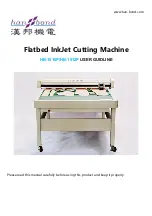
17
Operation
MAN1248 (2/26/2018)
Operating Extension Cylinder
Verify that transport bar is disengaged from deck and
holstered. Verify that extension is properly greased
before operating. When operating cylinder, make sure
that areas where deck will extend or retract are free of
obstacles. Do not extend or retract the deck as a
means for starting a cutting operation.
NOTICE
■
Never install a double-acting cylinder as
damage to the cutter will occur.
Tractor and Cutter Operation
Full chain shielding must be installed at all
times. Thrown objects could injure people or dam
-
age property.
• If the machine is not equipped with full chain
shielding, operation must be stopped.
• This shielding is designed to reduce the risk
of thrown objects. The mower deck and protec
-
tive devices cannot prevent all objects from
escaping the blade enclosure in every mowing
condition. It is possible for objects to ricochet
and escape, traveling as much as 300 feet
(92m).
Keep bystanders away from equipment.
Never allow riders on power unit or attachment.
This cutter is operated with tractor controls
.
Engage the
PTO control at idle rpm to prevent undue stress on
tractor
,
cutter drivelines and gearboxes
.
Set tractor
PTO speed and tractor throttle to operate at either 540
rpm or 1000 rpm, depending on which model cutter you
have
.
Change ground travel by using higher or lower
gears
.
Be sure operator is familiar with all tractor con
-
trols and can stop it and the cutter in an emergency
.
The operator should give complete
,
undivided attention
to operating the tractor and cutter when mowing
.
Brush and Ditch Bank Mowing
Never direct discharge toward people, animals,
or property.
■
Do not raise cutter head with PTO engaged.
A raised cutter head exposes blades and
increases thrown object hazards. Always operate
with cutter head close to surface being cut.
When operating this cutter on ditch banks and cutting
brush, the operator must be alert. Should the cutter hit
an obstruction, the front of the tractor will usually slide
toward the ditch (to the right). It would be possible to
run the tractor and cutter into the ditch if mowing speed
is too high or operator is not alert. On steep banks, it
may be necessary to use the left turning brake to coun
-
teract the load occurring when cutter is hitting brush.
This cutter can handle brush up to 2" without serious
damage if reasonable judgement is used. Sometimes,
in ditches, it is well to raise the hitch and cutter head as
high as needed and then lower it gradually onto top of
brush. This will produce a good shredding job and
usually is the best method for heavy brush.
When mowing steep banks with cutter on the uphill
side, it is possible to raise cutter head high enough to
over-center and make it difficult to lower. When this
occurs, it will be necessary to maneuver tractor to
cause lowering to take place.
Hydraulic Drive
All adjustments to the hydraulic drive system have
been made at the factory. It is designed to flow 20 gpm
of oil up to 4000 psi pressure. The pressure relief valve
is set for 4000 psi.
When the mower is overloaded, the pressure relief
valve will operate as oil is by-passed. When this
occurs, stop the tractor, or back up, to start the mower
blades rotating again. Continued by-passing of oil "over
relief" will overheat the unit and can cause damage to
hydraulic components.
The DBH5.31 and DBH6.31 mowers are supplied with
a temperature gauge mounted on top of the reservoir. If
the oil temperature gets over 180°F, stop mowing until
this temperature drops to a safe level. This gauge is to
aid in obtaining maximum use from the mower.
For operating in highly loaded conditions, consider
adding the cooler option to the hydraulic tank. See
page 55.
■
Frequent or continuous contact of blades with
the ground will cause mower hydraulic oil to over
-
heat and may cause cutter damage. Be sure to fol
-
low initial start-up instructions before operating for
the first time.
DANGER
DANGER
WARNING
WARNING
A
CAUTION
















































